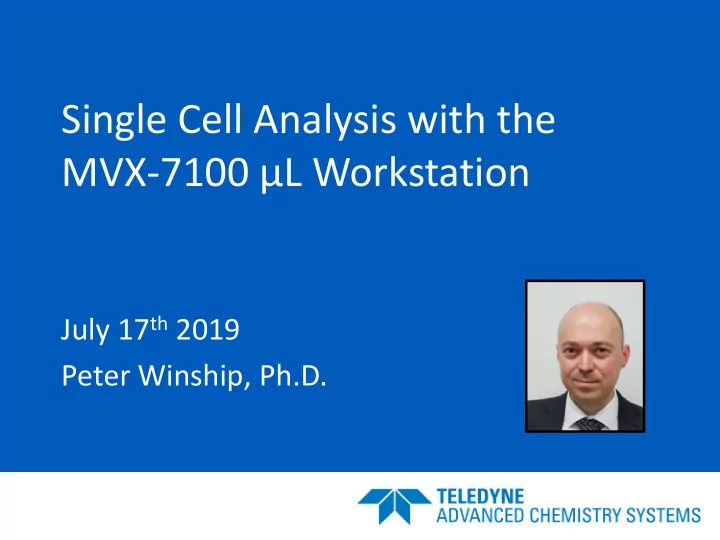

Single Cell Analysis with the MVX-7100 µL Workstation July 17 th 2019 Peter Winship, Ph.D.
Webinar Agenda • An introduction to cell analysis with ICP-MS
Webinar Agenda • An introduction to cell analysis with ICP-MS • The single cell analysis
Webinar Agenda • An introduction to cell analysis with ICP-MS • The single cell analysis • From sample to data: the single cell workflow – Automation – Glassware interface – ICP-MS
Webinar Agenda • An introduction to cell analysis with ICP-MS • The single cell analysis • From sample to data: the single cell workflow – Automation – Glassware interface – ICP-MS • Wider analytical considerations
Cell Analysis and ICP-MS
Cell Analysis and ICP-MS • The latest generation of ICP-MS affords the sensitivity and speed to detect ‘single events’ • Huge area of research and analysis in the elemental composition of eukaryotic and prokaryotic cells – Elemental content of individual cells – Cellular uptake of species (nutrient/contaminant) – Uptake of metal based drug compounds, nanoparticles
The Single Cell Analysis
The Single Cell Analysis • Dissolved analyte: continuous sample introduction Intensity Dwell time Time • Suspension of cells: individual cells produce an ion plume Intensity Dwell time Time
The Single Cell Analysis • Individually introduced cells produce an ion plume in plasma • Number of events equivalent to cell number concentrations • Signal intensity of events equivalent to element mass in individual cells
From Sample to Data: The Single Cell Workflow
The Analytical Workflow Sample Automation Interface ICP-MS Data
The Analytical Workflow Sample Automation Interface ICP-MS Data • Transport Efficiency: Maximum • Maintain Cell Integrity • Numerous variables
Sample • Consider the cell processes prior to analysis • Samples delivered in certain media • Samples in well plates/tubes/vials • Are there conditions to maintain? – E.g. temperature? • Any other considerations? – Cell gravitational settling?
Automation • MVX-7100 µL Workstation – Syringe driven automation – Sample volume: 5 µL to 1.5 mL – Control of introduction flow rate (nL min -1 to mL min -1 ) – Sample homogenization – Temperature control (4°C to 40°C) – Sampling from vials/tubes – Sampling from 96 or 384 well plates
Glassware Interface: Glass Expansion • High efficiency nebulizer • Introduction flow rates < 50 µL min -1 • Wide bore capillary • On axis, high efficiency spray chamber • Additional spray chamber gas flow focusses nebulized sample • ‘Near total consumption’
Glassware Interface: Glass Expansion
Confirmation of Cell Integrity • K562 cell line – Human Myeloid Leukemia cells – 10 to 20 µm size – Widely used in research – Easy to culture and isolate Images courtesy of Agilent Technologies 20 µm
Confirmation of Cell Integrity Post nebulisation Intact Nebuliser Gas Flow = 0.1 L min -1 Tris-HCl 50 mM MVX-7100 µL Workstation Sample Loop and 6 Port Switching Valve Intact Lysis Nebuliser Gas Flow = 0.7 L min -1 Images courtesy of Agilent Technologies
ICP-MS Instrumentation • Analytical sensitivity – The more sensitivity available the better – Broad range of associated analyte concentrations • Analyte suite? – Multiple analytes: the analyte of interest and a co-factor? – Full suite from ICP-TOF-MS • Data processing – What is the data output? – Concentration/population number/cell size? – Analyte per unit x?
Data Output Example Regular Yeast Selenised Yeast 31 P + > 31 P 16 O + 31 P + > 31 P 16 O + 80 Se + > 80 Se 16 O + 80 Se + > 80 Se 16 O +
Wider Analytical Considerations
Wider Considerations and Further Work • Standardisation – How do we standardize? – Cell size/cell shape/cell integrity • Quality control • Interlaboratory comparison – Standardisation and QC testing • High TDS testing
Acknowledgements
Acknowledgements • Agilent Technologies • Glyn Russell, Glass Expansion • Jorg Bettmer, University of Oviedo, Spain • Dr Tanaka and Prof. Ogra, Chiba University, Japan
Thank You For Your Attention Please forward questions to pete.winship@teledyne.com
www.teledynecetac.com
Peter Winship, Ph.D MVX-7100 µL Workstation Product Manager pete.winship@teledyne.com
Recommend
More recommend